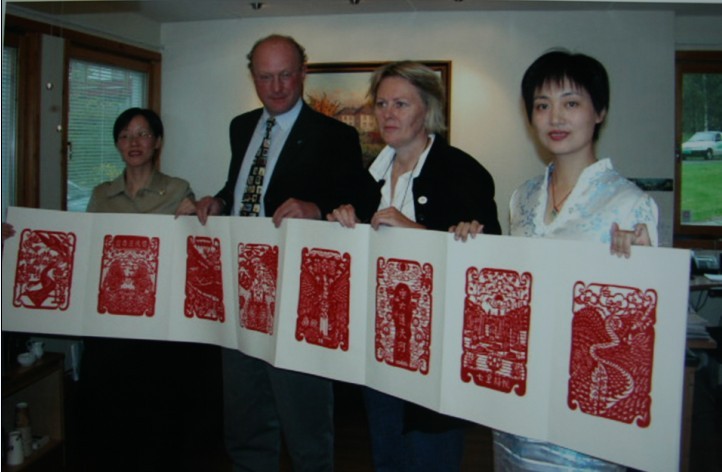more>>More News
- National Day
- ways to integrate into Chinese style life
- Should they be in the same university with me?!!
- Chinese Ping Pang Legend: the Sun Will Never Set
- A Glance of those Funny University Associations
- mahjong----The game of a brand new sexy
- Magpie Festival
- Park Shares Zongzi for Dragon Boat Festival
- Yue Fei —— Great Hero
- Mei Lanfang——Master of Peking Opera
Chinese Traditional Art---- Papercut
By admin on 2014-12-16

Papercuts refer to handicrafts made by cuttingpaperwith scissors to form different patterns and pasting them on walls, windows, doors and ceilings. With their long history, papercuts, which originated in China, have been very popular among the ordinary people of China. The first papercut can be traced back to theNorthern and Southern Dynasties(386-581) period. The initiation and spread of papercuts had a close relationship with Chinese rural festivals. People pasted papercuts on walls, windows and doors at wedding ceremonies or festivals to enhance the festive atmosphere.
Chinese papercuts are rich in content. The auspicious designs symbolize good luck and the avoidance of evil. The child, lotus and bottle gourd designs suggest a family with a large number of children and grandchildren. Domestic birds, livestock, fruit, fish and worms are also familiar objects depicted by Chinese farmers. There are some special papercuts of traditional design used as patterns for embroidering clothes,shoes, hats, pillows, bed curtains and door curtains. Papercuts made in different areas have different characteristics. Shaanxi window papercuts are simple and bold; papercuts fromHebei ProvinceandShanxi Provinceare bright in color; papercuts in southern provinces are delicate and fine.
Although papercuts are simple to make, their themes reveal many local Chinese customs. Papercuts typically demonstrate the preferred aesthetics of shape and the artistic concepts behind Chinese folk handicrafts. An understanding and scrutiny of papercuts is a good beginning to getting to know and appreciate the complexity of Chinese folk arts.
The art forms are mainly used as decorations and
patterns for religious and ornamental purposes. Papercuts can also be used as
ornaments on gates, windows, walls, columns, mirrors, lamps andlanterns. They
are still widely used today at important festivals, especially during the New
Year. It is very important to put papercuts at the entrance gates for good luck
for the family. Papercuts can also serve as presents or as decorations on gifts
and sacrificial offerings to the ancestors or gods. In addition, they can be
used as embroidery patterns for clothes and lacquer works.
As an art, folk
papercuts imitate nature in the shape of characters, symbols and other designs.
Various paper objects were buried with the deceased or burned with other
symbolic figures of the dead. This practice is still observed in some parts of
China.
Paper and scissors are the usual materials utilized, but sometimes an engraving knife is used. Papercuts are all hand-made. There are two common practices for making papercuts: scissors- and knife-cutting techniques. In the first technique, about eight paper strips are fastened together to form a pattern. The artist cuts the motif with a pair of sharp, pointed scissors to attain the desired pattern. Knife cutting, on the other hand, is where the artist puts several layers of paper on a relatively soft foundation consisting of a mixture of tallow and ashes. The artist then holds a sharp knife vertically and cuts the motif out of the paper by following a pattern. More papercuts are made with the knife-cutting technique rather than scissors since it is less time consuming.
In Chinese folk culture, the art ofpaper cuttinghas
a significant status in folk activities. Professionalpaper-cutting craftsmen
have been around as early as theSouthern Song Dynasty(1127-1279). Papercutting
was once a handicraft that every native girl mastered. Paper-cut craftsmanship
was often used to select brides-to-be. Currently, papercutting craftsmanship is
mostly evident among countrywomen.
- Contact Us
-
Tel:
0086-571-88165708
0086-571-88165512E-mail:
admission@cuecc.com
- About Us
- Who We Are What we do Why CUECC How to Apply
- Address
- Study in China TESOL in China
Hangzhou Jiaoyu Science and Technology Co.LTD.
Copyright 2003-2024, All rights reserved




 Chinese
Chinese
 English
English
 Korean
Korean
 Japanese
Japanese
 French
French
 Russian
Russian
 Vietnamese
Vietnamese
